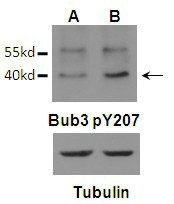
Western blot analysis of Bub3 (Phospho-Tyr207)Antibody (arrow indicated) in U87 (A) and U87 EGFRvIII (B) cells in Mitosis.
Phospho-BUB3 (Tyr207) Antibody
CSB-PA117544
ApplicationsWestern Blot, ELISA
Product group Antibodies
ReactivityHuman, Mouse, Rat
TargetBUB3
Overview
- SupplierCusabio
- Product NamePhospho-BUB3 (Tyr207) Antibody
- Delivery Days Customer20
- ApplicationsWestern Blot, ELISA
- CertificationResearch Use Only
- ClonalityPolyclonal
- ConjugateUnconjugated
- Gene ID9184
- Target nameBUB3
- Target descriptionBUB3 mitotic checkpoint protein
- Target synonymsBUB3 budding uninhibited by benzimidazoles 3 homolog; BUB3L; budding uninhibited by benomyl; budding uninhibited by benzimidazoles 3 homolog; hBUB3; mitotic checkpoint component; mitotic checkpoint protein BUB3; testicular tissue protein Li 27
- HostRabbit
- IsotypeIgG
- Protein IDO43684
- Protein NameMitotic checkpoint protein BUB3
- Scientific DescriptionHas a dual function in spindle-assembly checkpoint signaling and in promoting the establishment of correct kinetochore-microtubule (K-MT) attachments. Promotes the formation of stable end-on bipolar attachments. Necessary for kinetochore localization of BUB1. Regulates chromosome segregation during oocyte meiosis. The BUB1/BUB3 complex plays a role in the inhibition of anaphase-promoting complex or cyclosome (APC/C) when spindle-assembly checkpoint is activated and inhibits the ubiquitin ligase activity of APC/C by phosphorylating its activator CDC20. This complex can also phosphorylate MAD1L1.??Seeley T.W., Wang L., Zhen J.Y.Biochem. Biophys. Res. Commun. 257:589-595(1999)Tang Z., Shu H., Oncel D., Chen S., Yu H.Mol. Cell 16:387-397(2004)Logarinho E., Resende T., Torres C., Bousbaa H.Mol. Biol. Cell 19:1798-1813(2008)?
- ReactivityHuman, Mouse, Rat
- Storage Instruction-20°C or -80°C
- UNSPSC12352203
